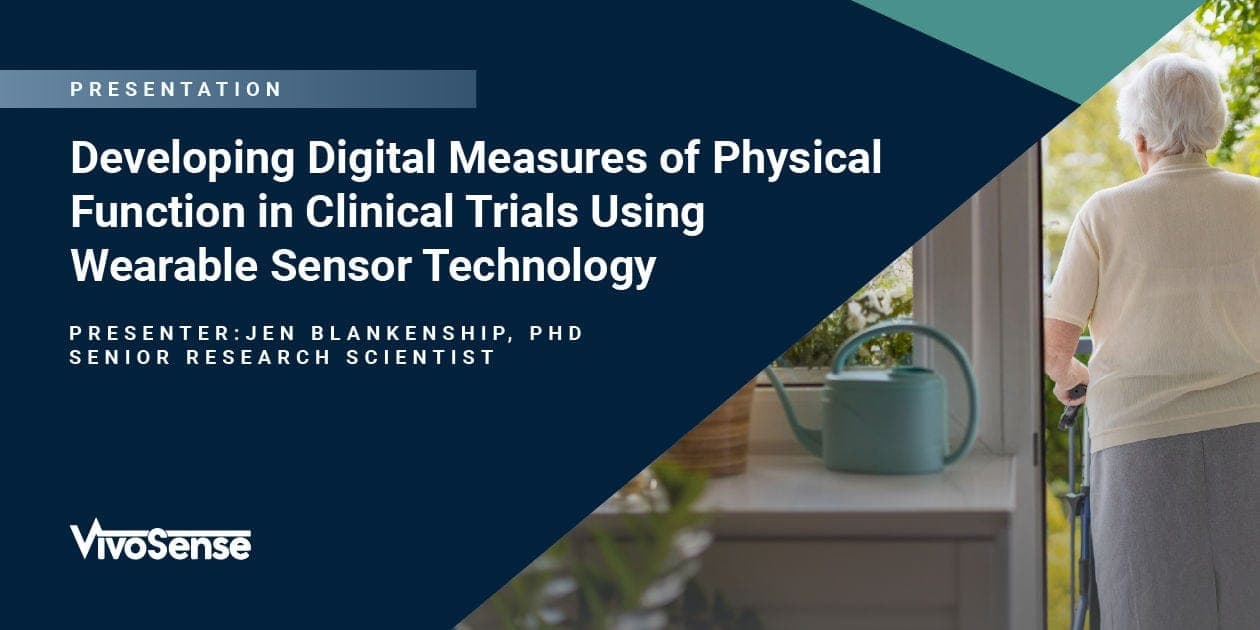See how research teams can start using wearables to identify novel digital biomarkers to efficiently generate real-world patient evidence in clinical trials.

Many clinical researchers are exploring novel digital endpoints derived from wearable and connected digital health technologies (DHTs) to generate real-world patient evidence in clinical trials.
DHTs can be deployed remotely to collect data continuously for extended periods of time. High-frequency data streams can be used to derive novel digital endpoints that capture treatment-induced changes more rapidly and with higher levels of sensitivity than established episodic endpoints. Ultimately, novel digital endpoints can improve the efficiency and efficacy of the drug development process by increasing the speed of clinical trials, reducing costs, and enabling faster decision-making.
The FDA’s Patient-Focused Drug Development initiative encourages sponsors to systematically incorporate the patient’s voice throughout the entire drug development process and capture endpoints that represent meaningful aspects of the patient experience. Aspects of health like physical function, mobility, and sleep are relevant and meaningful to patients across multiple therapeutic areas and can be assessed using wearable sensors in home environments to provide truly patient-centric and meaningful endpoints in clinical trials.
In the following presentation, Dr. Jen Blankenship shared details about one of VivoSense’s ongoing pilot studies, which aims to develop and validate novel methods to capture aspects of real-world walking behavior with actigraphy sensors in older adults with and without mild Alzheimer’s disease.
WATCH | DOWNLOAD SLIDES | READ
On-Demand Webinar Presentation
Developing Digital Measures of Function Using Wearable Sensors for Alzheimer’s Disease
Formatted Transcript
Functional Independence Matters to Patients with Alzheimer’s Disease
Functional independence is an aspect of health that matters enormously to patients with Alzheimer’s disease. When you ask patients, their caregivers, and healthcare professionals, as seen in this Venn diagram (Fig. 1), maintaining independence, autonomy, and functioning is among the most important aspects of life for this patient population.

Established Approach to Measuring Function in Alzheimer’s
(30:26) The aspects of physical function that are important to key stakeholders are also reflected in how drugs are evaluated in Alzheimer’s disease. There has been a lot of news in the world of drug development in Alzheimer’s disease. For example, the drug Lecanemab was granted traditional approval by the FDA for treating early Alzheimer’s disease.
 Figure 2 shows some data from that clinical trial. The primary endpoint in this pivotal trial for Lecanemab was the clinical dementia rating sum of boxes. For those unfamiliar with this endpoint, it’s a composite assessment of cognitive and functional domains. It asks people close to someone who has Alzheimer’s disease questions about how they’re able to function and remember things.
Figure 2 shows some data from that clinical trial. The primary endpoint in this pivotal trial for Lecanemab was the clinical dementia rating sum of boxes. For those unfamiliar with this endpoint, it’s a composite assessment of cognitive and functional domains. It asks people close to someone who has Alzheimer’s disease questions about how they’re able to function and remember things.
There are eight different domains that it captures. The important point is that this is a primary endpoint for many clinical trials and drug development in Alzheimer’s disease and is the indicator that Lecanemab, in fact, delayed the progression of Alzheimer’s disease for patients.
 (31:48) An additional endpoint often used captures daily living activities. Both instrumental and basic activities of daily living are captured in these scales (Fig. 3). These endpoints are assessed intermittently in both cases. At its highest, most frequent resolution, we’re looking at assessments every three months. There’s a lot of variability in what’s happening with people between those times.
(31:48) An additional endpoint often used captures daily living activities. Both instrumental and basic activities of daily living are captured in these scales (Fig. 3). These endpoints are assessed intermittently in both cases. At its highest, most frequent resolution, we’re looking at assessments every three months. There’s a lot of variability in what’s happening with people between those times.
Limitations of Existing Methods of Function
Additionally, these types of endpoints are subject to rater and recall bias. We rely on asking informants questions, often reflecting very long recall periods. One example from the ADL questionnaires is that the questions are often phrased in the frame of “over the last four weeks, has Bob been able to dress independently?”
While this reflects someone’s ability to function on a high level, it captures a limited window of what they can do and doesn’t holistically reflect their lived experience. Patients assessed in clinic settings don’t capture the everyday functional challenges that older adults may experience in real-world environments.
The Problem
There is an unmet need right now to develop new methods to capture functioning more holistically and other aspects related to function that matter to patients with Alzheimer’s disease.
Opportunities for Wearable Actigraphy Sensors in Alzheimer’s
We see lots of opportunities with wearable actigraphy sensors to fill these gaps. Wearable actigraphy sensors are low burden and capture many aspects and measures of physical behavior carried out in daily life, such as walking and physical activities, sedentary behaviors, sleep, and other behaviors that are difficult to measure when you ask somebody to recall them later. Patients can wear these technologies continuously and passively to assess movement and capture aspects of function in and outside the home.
(35:44) While measures of physical function from wearable sensors don’t provide the entire picture, they can give a complimentary data stream to existing measures of function that ask participants to report how they’re doing subjectively. One of the most significant advantages of wearable sensors in the context of drug development is that they have the potential to detect treatment effects more efficiently than existing endpoints.
Many endpoints in Alzheimer’s disease and across other clinical trials are assessed episodically over extended periods, leading to long-duration clinical trials that translate to high costs for pharma and high costs of drug development. By enabling these digital health technologies and wearable sensors and identifying endpoints that can capture changes with higher sensitivity, there is increased potential to detect treatment benefits or lack of benefits more efficiently, increasing the speed of the overall drug development cycle.
Assessing Walking Behaviors in AD with Actigraphy Sensors
(37:06) While wearable sensors have been quite prevalent in the context of the research space, they’re less well adopted in drug development and the pharmaceutical space. In part, this is due to some gaps in evidence.
One piece of evidence you need to bring to the FDA when demonstrating that a new digital endpoint is showing or measuring something important in your clinical trial is that the endpoint is actually measuring the data you say it’s measuring. With wearable actigraphy sensors, there’s a high potential to capture aspects of walking behavior central to mobility and functional independence.
The challenge is that most of the algorithms available to derive measures of walking behavior from these sensors were developed in healthy populations. It is very problematic because there is ample evidence to demonstrate that when you apply algorithms developed in healthy populations in cohorts with slower walking patterns or clinical populations like individuals with Alzheimer’s disease, you have a significant algorithmic bias.
(38:40) Fig. 4 shows, at different gait speeds, the percent error, or difference, from manually counted steps that these two different actigraphy sensors are generating. You can see that as the walking speed gets slower, the percent error gets much larger, which is problematic if you claim these sensors capture an endpoint that matters for your patient population. This measurement problem is central to our MassAITC pilot project and work in our R&D department.

Obtaining Regulatory Qualification
Our long-term research goal is to obtain regulatory qualification for a real-world digital measure of function for patients with Alzheimer’s disease. A qualification is a regulatory opinion that the physical function you are trying to measure is well-defined and a reliable assessment of that function. It allows pharmaceutical companies to use that measure in their clinical trials, and the FDA will accept that this is good enough for regulatory decision-making.
The evidence needed to get that regulatory qualification opinion is that the measure you capture matters to patients: you can reliably quantify it with a given piece of technology or approach, and there’s clinical significance that it matters to the disease itself.
MassAITC Pilot Study Specific Aims
This approach to digital biomarker discovery feeds into our MassAITC pilot study, which has three aims.
- Address the measurement problem by developing and validating novel machine-learning methods to detect walking behaviors from inertial sensors.
- Validate the clinical meaningfulness of digital biomarkers of real-world walking behavior in real-world environments.
- Evaluate whether these technologies are feasible and acceptable for use in real-world environments.
(41:06) These aims align with the evidence needed for regulatory qualification. We are at the beginning of this work, but here’s a quick snapshot of where we’re going in the long term.
Muli-disciplinary Academic-Industry Partnership
Our team is a multidisciplinary academic-industry collaboration, bringing together experts in digital health, aging signal processing, and motion capture systems to execute this project.
Participants
In our study, we’ll recruit 20 older adults, both with and without a self-reported diagnosis of mild Alzheimer’s disease. All participants will be at least 65 years or older and free from other types of dementia, traumatic brain injury or cerebrovascular stroke. All participants will have a self-reported diagnosis.
Study Design: Aim 1 -In-Clinic Measures
On a high level, our study has two components: an in-lab component where participants will visit the motion capture laboratory at UMass Amherst, where they’ll perform multiple walking tasks while wearing several wearable sensors at multiple wear locations while being assessed with a motion capture system. Our truth data will come from the motion capture system data, and that data will be used to develop machine learning algorithms to derive measures of real-world walking behavior.
Study Design: Aims 2 and 3 – Real-World Measures
Those algorithms will then be applied to another data stream we’re collecting: two weeks of real-world monitoring. Participants will be asked to wear monitors on their wrists and thighs for two weeks to assess their functioning and walking behaviors at home.
We’ll evaluate group differences in these walking behavior measures to determine whether some outcomes can detect differences in older adults with and without Alzheimer’s disease.
After participants complete the wearable sensor period, they’ll be asked to complete a questionnaire about their wearable sensor experience. There’s limited data about how patients with Alzheimer’s disease accept this type of technology, so this is relatively novel.
We’ll generate a summary report of the patient’s walking behavior and give it to them after completing the two-week wear period. They’ll complete another questionnaire to evaluate how meaningful that data is to them.
Delivering wearable sensor data back to participants meaningfully is a very important topic in the pharma world, and this data will generate that type of evidence.
Improved Alzheimer’s Care and Treatment
We see the long-term vision and potential for digital measures and digital endpoints in the context of drug development and the pharmaceutical world to enable a better care model for patients with Alzheimer’s disease and older adults without. This type of monitoring can help facilitate conversations, identify points at which significant changes and functions are happening, and help guide treatment decisions. This type of technology will enable a more connected model of care in the future.
{{cta(‘357984d4-93b0-45ff-ba7f-cae44042426a’)}}
Jen Blankenship, PhD
Jen Blankenship, PhD, is a clinical and translational scientist with a deep interest in wearable technology (e.g., continuous glucose monitors and accelerometers).

